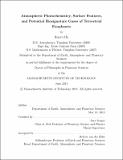| dc.contributor.advisor | Sara Seager. | en_US |
| dc.contributor.author | Hu, Renyu, Ph. D. Massachusetts Institute of Technology | en_US |
| dc.contributor.other | Massachusetts Institute of Technology. Department of Earth, Atmospheric, and Planetary Sciences. | en_US |
| dc.date.accessioned | 2013-11-18T17:34:59Z | |
| dc.date.available | 2013-11-18T17:34:59Z | |
| dc.date.copyright | 2013 | en_US |
| dc.date.issued | 2013 | en_US |
| dc.identifier.uri | http://hdl.handle.net/1721.1/82168 | |
| dc.description | Thesis (Ph. D.)--Massachusetts Institute of Technology, Dept. of Earth, Atmospheric, and Planetary Sciences, 2013. | en_US |
| dc.description | This electronic version was submitted by the student author. The certified thesis is available in the Institute Archives and Special Collections. | en_US |
| dc.description | Cataloged from student-submitted PDF version of thesis. | en_US |
| dc.description | Includes bibliographical references (p. 269-304). | en_US |
| dc.description.abstract | The endeavor to characterize terrestrial exoplanets warrants the study of chemistry in their atmospheres. Here I present a comprehensive one-dimensional photochemistry-thermochemistry model developed from the ground up for terrestrial exoplanet atmospheres. With modern numerical algorithms, the model has desirable features for exoplanet exploration, notably the capacity to treat both thin and thick atmospheres ranging from reducing to oxidizing, and to find steady-state solutions starting from any reasonable initial conditions. These features make the model the first photochemistry-thermochemistry model applicable for non-hydrogen-dominated thick atmospheres on terrestrial exoplanets. Using the photochemistry model, I explore the compositions of thin atmospheres on terrestrial exoplanets controlled by surface emission and deposition of gases. Highlights of my findings are: (1) oxygen and ozone may build up in 1-bar CO2 atmospheres to levels that have conventionally been accepted as unique signatures of life, if there is no surface emission of reducing gases; (2) volcanic carbon compounds (CH4 and CO2) are likely to be abundant in terrestrial exoplanet atmospheres; but volcanic sulfur compounds (H2S and SO2) are chemically short-lived and therefore cannot accumulate in virtually any types of terrestrial exoplanet atmospheres. Also using the photochemistry model, I explore the ranges of molecular compositions of thick atmospheres on terrestrial exoplanets. I find that carbon has to be in the form of CO2 in a H2-depleted water-dominated atmosphere, and that the preferred loss of light elements from an oxygen-poor and carbon-rich atmosphere leads to formation of unsaturated hydrocarbons (C2H2 and C2H4). These results imply that chemical stability has to be taken into account when interpreting the spectrum of a super Earth/mini Neptune like GJ 1214b. Another intriguing category of terrestrial exoplanets is bare-rock exoplanets. I present the first theoretical framework to compute disk-integrated spectrum from a bare-rock exoplanet, taking into account the reflectivity and emissivity of solid minerals on the surface. I find that silicate surfaces lead to prominent spectral features in the 8 - 13 [mu]m range, detectable by mid-infrared spectroscopy using transit. Therefore transit spectroscopy is an independent method to confirm the rocky nature of an exoplanet. | en_US |
| dc.description.statementofresponsibility | by Renyu Hu. | en_US |
| dc.format.extent | 304 p. | en_US |
| dc.language.iso | eng | en_US |
| dc.publisher | Massachusetts Institute of Technology | en_US |
| dc.rights | M.I.T. theses are protected by
copyright. They may be viewed from this source for any purpose, but
reproduction or distribution in any format is prohibited without written
permission. See provided URL for inquiries about permission. | en_US |
| dc.rights.uri | http://dspace.mit.edu/handle/1721.1/7582 | en_US |
| dc.subject | Earth, Atmospheric, and Planetary Sciences. | en_US |
| dc.title | Atmospheric photochemistry, surface features, and potential biosignature gases of terrestrial exoplanets | en_US |
| dc.type | Thesis | en_US |
| dc.description.degree | Ph.D. | en_US |
| dc.contributor.department | Massachusetts Institute of Technology. Department of Earth, Atmospheric, and Planetary Sciences | |
| dc.identifier.oclc | 861505109 | en_US |
